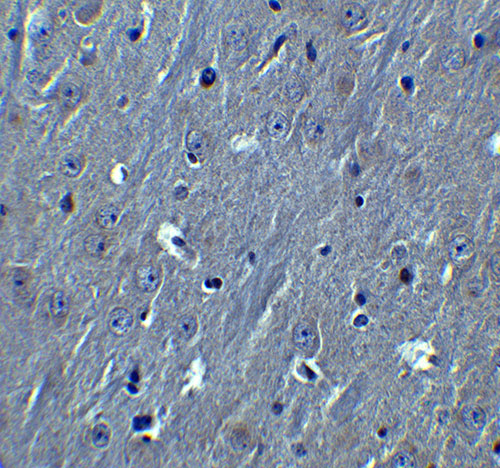HOOK3 Antibody
- 产品详情
- 实验流程
- 背景知识
Application
| WB, IHC, E |
|---|---|
| Primary Accession | Q86VS8 |
| Other Accession | NP_115786, 14165274 |
| Reactivity | Human, Mouse, Rat |
| Host | Rabbit |
| Clonality | Polyclonal |
| Isotype | IgG |
| Calculated MW | 83126 Da |
| Concentration (mg/ml) | 1 mg/mL |
| Conjugate | Unconjugated |
| Application Notes | HOOK3 antibody can be used for the detection of HOOK3 by Western blot at 1 - 2 µg/mL. Antibody can also be used for immunohistochemistry at 10 µg/ml. |
| Gene ID | 84376 |
|---|---|
| Other Names | Protein Hook homolog 3, h-hook3, hHK3, HOOK3 |
| Target/Specificity | HOOK3; HOOK3 antibody is human, mouse and rat reactive. HOOK3 antibody is predicted to not cross-react with HOOK1 and HOOK2. |
| Reconstitution & Storage | HOOK3 antibody can be stored at 4℃ for three months and -20℃, stable for up to one year. |
| Precautions | HOOK3 Antibody is for research use only and not for use in diagnostic or therapeutic procedures. |
| Name | HOOK3 (HGNC:23576) |
|---|---|
| Function | Acts as an adapter protein linking the dynein motor complex to various cargos and converts dynein from a non-processive to a highly processive motor in the presence of dynactin. Facilitates the interaction between dynein and dynactin and activates dynein processivity (the ability to move along a microtubule for a long distance without falling off the track). Predominantly recruits 2 dyneins, which increases both the force and speed of the microtubule motor (PubMed:25035494, PubMed:33734450). Component of the FTS/Hook/FHIP complex (FHF complex). The FHF complex may function to promote vesicle trafficking and/or fusion via the homotypic vesicular protein sorting complex (the HOPS complex). May regulate clearance of endocytosed receptors such as MSR1. Participates in defining the architecture and localization of the Golgi complex. FHF complex promotes the distribution of AP-4 complex to the perinuclear area of the cell (PubMed:32073997). |
| Cellular Location | Cytoplasm, cytoskeleton. Golgi apparatus. Note=Enriched at the cis-face of the Golgi complex. Localizes to microtubule asters in prophase (PubMed:11238449). Localizes to the manchette in elongating spermatids (By similarity). {ECO:0000250|UniProtKB:Q8BUK6, ECO:0000269|PubMed:11238449} |
For Research Use Only. Not For Use In Diagnostic Procedures.
Provided below are standard protocols that you may find useful for product applications.
BACKGROUND
The HOOK proteins (HOOK1, HOOK2 and HOOK3) comprise a family of cytosolic coiled-coil proteins that contain conserved N-terminal domains, which attach to microtubules mediating the spatial organization of diverse membrane-trafficking systems; their more divergent C-terminal domains mediate binding to organelles (1,2). HOOK3 exists as a homodimer and participates in defining the architecture and localization of the Golgi complex through its central coiled-coil domain (3). HOOK3 may regulate clearance of endocytosed receptors such as MSR1 (3,4).
REFERENCES
Walenta JH, Didier AJ, Liu X, et al. The Golgi-associated hook3 protein is a member of a novel family of microtubule-binding proteins. J. Cell Biol. 2001; 152:923-34.
Sano H, Ishino M, Krämer H, et al. The microtubule-binding protein Hook3 interacts with a cytoplasmic domain of scavenger receptor A. J. Biol. Chem. 2007; 282:7973-81.
Herrmann L, Wiegmann C, Arsalan-Werner A, et al. Hook proteins: association with Alzheimer pathology and regulatory role of hook3 in amyloid beta generation. PLoS One 2015; 10:e0119423.
Ciampi R, Giordano TJ, Wikenheiser-Brokamp K, et al. HOOK3-RET: a novel type of RET/PTC rearrangement in papillary thyroid carcinoma. Endocr. Relat. Cancer 2007; 14:445-52.
终于等到您。ABCEPTA(百远生物)抗体产品。
点击下方“我要评价 ”按钮提交您的反馈信息,您的反馈和评价是我们最宝贵的财富之一,
我们将在1-3个工作日内处理您的反馈信息。
如有疑问,联系:0512-88856768 tech-china@abcepta.com.























 癌症的基本特征包括细胞增殖、血管生成、迁移、凋亡逃避机制和细胞永生等。找到癌症发生过程中这些通路的关键标记物和对应的抗体用于检测至关重要。
癌症的基本特征包括细胞增殖、血管生成、迁移、凋亡逃避机制和细胞永生等。找到癌症发生过程中这些通路的关键标记物和对应的抗体用于检测至关重要。 为您推荐一个泛素化位点预测神器——泛素化分析工具,可以为您的蛋白的泛素化位点作出预测和评分。
为您推荐一个泛素化位点预测神器——泛素化分析工具,可以为您的蛋白的泛素化位点作出预测和评分。 细胞自噬受体图形绘图工具为你的蛋白的细胞受体结合位点作出预测和评分,识别结合到自噬通路中的蛋白是非常重要的,便于让我们理解自噬在正常生理、病理过程中的作用,如发育、细胞分化、神经退化性疾病、压力条件下、感染和癌症。
细胞自噬受体图形绘图工具为你的蛋白的细胞受体结合位点作出预测和评分,识别结合到自噬通路中的蛋白是非常重要的,便于让我们理解自噬在正常生理、病理过程中的作用,如发育、细胞分化、神经退化性疾病、压力条件下、感染和癌症。







